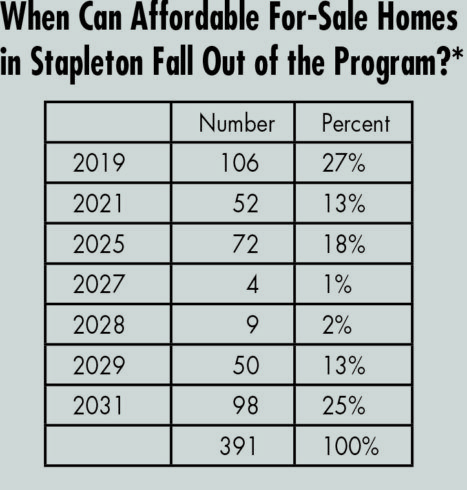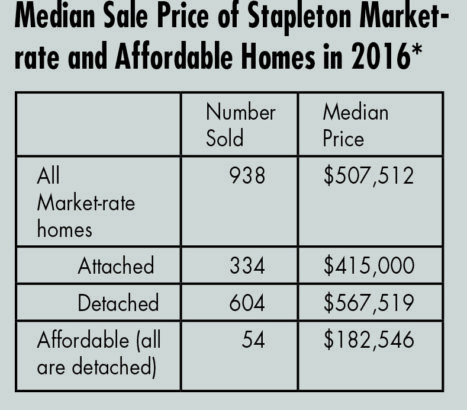
Mollie Fitzpatrick presents information from BBC Research’s study on home affordability in Stapleton to the Stapleton Foundation board.
Every residential and commercial sale in Stapleton pays the “community investment fee”—one-quarter of 1 percent of the property’s sale price (after the first $100,000). In 2016, proceeds from this fee totaled just over a million dollars. The fee is collected by the Master Community Association (MCA), which retains 5 percent. The rest of the money goes to the nonprofit Stapleton Foundation, an organization created to address community needs and quality of life issues for both Stapleton and surrounding communities. The foundation is now making affordable housing in Stapleton their primary focus.
The Stapleton Foundation recently commissioned BBC, a Denver research and consulting firm, to study “Housing Affordability in Stapleton.” The preliminary results of that study were presented to the foundation board on April 11; demographic information collected by BBC is graphically shown in the article on pages 24-25. The report states that households earning the area median income (AMI) will be priced out of Stapleton by 2031. Even at 150 percent AMI, BBC projects that if current trends continue, no more than 4 percent of Stapleton market-rate homes would be affordable to those households in 15 years. (The federal government calculates the AMI for a four-person household in Denver at $80,100.)
Households with an income at 80 percent of AMI qualify for Denver’s affordable program. These units are subject to a deed restriction that limits their resale price for 15 years (longer for some homes). Those deed restrictions begin phasing out in 2019 and could all expire by the year 2031. “We need to plug the hole in the dike that starts in 2019,” says Stapleton Foundation CEO Landri Taylor.
The BBC report says only aggressive “market interventions” can overcome this projected loss of affordable housing in Stapleton. A subcommittee of the foundation’s board is studying the best approach for preserving the existing supply of income-qualified, for-sale housing units. And Taylor has directed BBC to study models that exist elsewhere for preservation of such units.
The full foundation board will take up the committee’s recommendation in September.
At the end of 2016, Stapleton had a total of 6,961 for-sale homes. Of those homes, 391 had been built as part of Denver’s affordable program. The 391 affordable homes that existed in December 2016 can all drop out of the affordable program by 2031 if they are not purchased and again placed in affordable program status.
The big challenge in such a preservation program is, of course, capital to acquire a meaningful number of such housing units. The community investment fee, combined with funds from other sources, could be used for that purpose.
Socioeconomic diversity has long been viewed as necessary for Stapleton to fulfill its vision of looking like the larger Denver community. Demographic data from the BBC report, shown on pages 24-25, highlight the ways Stapleton’s population differs from (rather than reflects) Denver as a whole—Stapleton is whiter, has higher incomes, has more children, lives in larger homes, and has a higher percentage of home ownership. Home prices, as shown below, also differ from Denver’s median price.
Based on 562 sales, the median price for market rate for-sale housing in Stapleton is $508,000. For Denver as a whole, the median sale price for homes is about $327,000.
Fifty-four affordable (income-qualified) homes were sold in Stapleton in 2016, with a median price of $182,546.
The breakdown of 2016 Stapleton sales by price range is contained in the BBC report, which is linked here: https://frontporchne.com/wp-content/uploads/2017/05/Pages-from-Stapleton-Affordability-Report-revised-final.pdf .
To some extent, the issue of affordable housing in Stapleton merely reflects a problem prevalent throughout Denver and indeed along the entire northern Front Range—housing prices are rising much faster than incomes. In fact, a recent report by ATTOM Data Solutions finds that of the 12 counties in the U.S. that have the least home affordability, seven are in northern Colorado.
However, what sets Stapleton apart is the fact that the city of Denver was the landowner that sold Stapleton for development with the goal of creating a neighborhood that reflects the city as a whole. The BBC report comes full circle, recommending that at least the 10 percent of affordable for-sale units be bought back before the deed restrictions on prices expire.
In a presentation to the Citizens Advisory Board on May 18, Taylor asserted that Forest City is ahead of schedule in meeting the 10 percent affordable for-sale goal. He also said, “In terms of affordability, we look better than Denver.” CAB co-chairs Gary Gordon and Jim Wagenlander challenged Taylor on those statements. Wagenlander said, “Sadly, Stapleton falls far short” of the diversity goals expressed in the Green Book, the master plan for redeveloping Stapleton Airport.
Taylor did say he shares BBC’s sense of alarm at decreasing affordability over time. He observes that today’s more healthy economy does contain one silver lining of potential benefit to affordable housing—“cash in the system looking for opportunities, looking for vehicles of investment.” He hopes the final BBC report can identify a link between such investment pools and the need to acquire affordable units in Stapleton and keep them affordable in perpetuity.
*Charts were created by Front Porch using statistics compiled by BBC Research & Consulting for the housing affordability study referenced above.



0 Comments